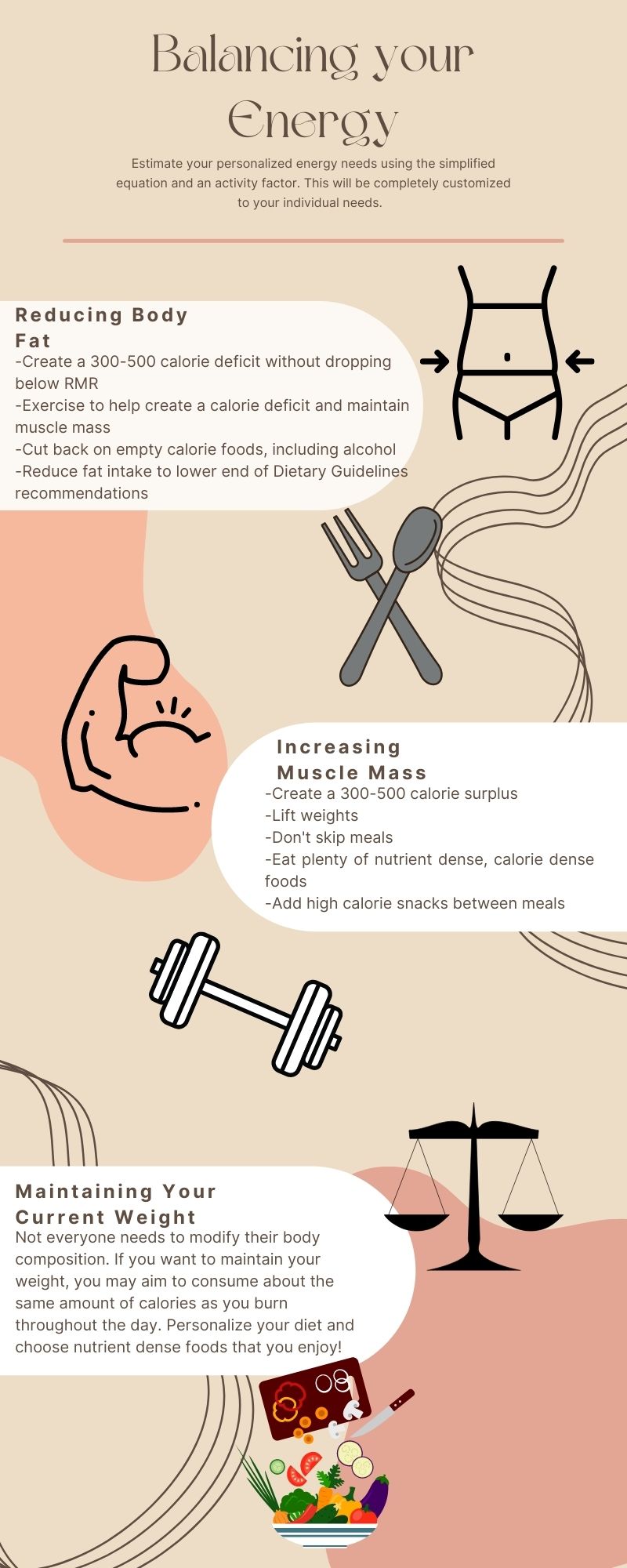3.4 Balancing Your Energy Equation
Now that you have a general idea of how your overall energy intake and expenditure work together, we will discuss strategies to help you balance your energy equation to meet your goals. You may have goals to increase your muscle mass, reduce your body fat, or just maintain the weight you are at right now. What’s important to understand is that your energy equation is personalized to you! The formula above gives you a ballpark estimate of the number of calories you burn each day but your metabolism may be slightly faster or slightly slower than this estimate. Your weight/body composition goals may be related to health or sports performance and it’s likely that your goals will change at multiple points throughout your life.
Strategies to Reduce Body Fat
If you are trying to lose weight, you will need a calorie deficit. This means that you will have to consume less calories from foods and beverages than your body burns on a daily basis. However, remember that creating a very large calorie deficit (not consuming enough calories to meet your RMR) can actually cause your metabolism to become more “energy efficient” and slow down. During periods of starvation, you are also likely to lose lean muscle mass which further slows down your metabolism. This is a reason why people often lose weight initially when they go on very restrictive diets, but then gain it all back and more when they start eating normally again. In order to lose weight in a healthy manner, an individual should aim for a calorie deficit of 300-500 calories per day. The larger the calorie deficit, the greater the chance that you lose lean muscle mass in addition to fat mass. This is not beneficial for your long term health. You can create a calorie deficit by eating less, exercising more, or a combination of the two. Ideally, an individual will participate in regular exercise to help maintain lean muscle mass. Here are some strategies to help with fat loss:
- Create a 300-500 calorie deficit without dropping below RMR
- Exercise to help create calorie deficit and maintain muscle mass
- Eat regular meals. If you skip meals, you will probably get very hungry and are more likely to binge.
- Cut back on empty calorie foods, including alcohol
- Increase protein intake to the higher end of the Dietary Guidelines recommendations
- Reduce fat intake to the lower end of the Dietary Guidelines recommendations
- Increase fiber intake from whole food sources
- Eat plenty of nutrient dense foods – even though your calorie intake is reduced, you still need the same number of micronutrients.
Increasing Muscle Mass
If your goal is to gain weight in a healthy manner or build muscle you must be in a calorie surplus and absolutely must lift weights. It is recommended to add an additional 300-500 kcals to your estimated total energy expenditure when bulking up. Many people are not aware of how many calories they burn on a daily basis. If you’ve been lifting weights for a long time and not seeing the progress you are looking for, you are likely not eating enough. Here are some strategies to help with weight gain:
- Create a 300-500 calorie surplus
- Lift weights
- Don’t skip meals
- Add high calorie snacks between meals
- Eat plenty of nutrient dense, calorie dense foods
- Drink whole milk, high calorie smoothies, or meal replacement beverages in addition to your regular meals to get extra calories
Maintaining Your Current Weight
Not everyone needs to modify their body composition. In fact, most of your adult life will probably be spent in “maintenance.” If your goal right now is just to maintain your weight, you will want to aim to consume approximately the same number of calories as you burn throughout the day. If you plan on increasing your activity level for health purposes, you may want to consider eating more calories to match your higher activity level. If you increase your activity level and don’t fuel your body with enough calories, you might start to feel fatigued, exhausted, and run down. Having a general idea of the number of calories that you need for your current activity level and body composition goals is the starting point to planning a healthy diet, personalized for you!
Figure 3.6 Balancing Your Energy Equation

Media Attributions
- Balancing Your Energy © Natalie Fox is licensed under a CC BY (Attribution) license
